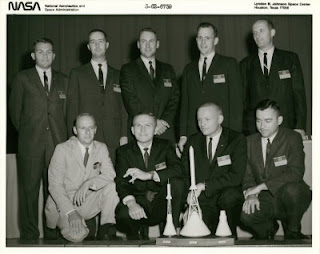Walter M. Schirra, "Wally" with model of Mercury spacecraft.
It was the morning of October 3, 1962, and Astronaut Wally Schirra awoke early. He had a large breakfast, which actually included a bluefish he had speared the day before while diving off the coast of Florida! After a pre-flight physical exam, and after suiting up, he was driven out to the launchpad at LC-14. Still before daylight, Schirra was lifted up to the special room on the gantry where he could board the spacecraft.
Schirra is helped into the cramped cockpit of the Mercury capsule. The Sigma 7 logo is seen to his left just below the window.
Schirra had nicknamed his capsule "Sigma 7." The greek letter sigma was used to represent "Engineering" and the 7 referred to the Mercury 7 astronauts. After the missed landing point and other flight difficulties encountered during the previous Mercury mission, Wally has determined to fly as perfect a mission as he could. He had to endure many changes to the planned flight, resulting in difficulties in training. There was a lot of pressure on NASA to extend the flight length of the mission, in order to start catching up to the Soviet space records. The Sigma 7 name therefor reflected the focus on flight operations and capsule testing rather than space exploration.
Liftoff of Mercury-Atlas 8 from Pad LC-14.
In the early morning hours at the Cape, blast-off occurred as normal but then the craft began to roll unexpectedly. Some flight controllers pondered an abort to the mission, but the small thrusters on the Atlas missile performed correctly and stopped the roll. The capsule was lifted into an orbit slightly higher than expected due to a 10-second delay in cutting off the engines. Mission Control confirmed the flight was "Go" for at least six orbits, maybe seven.
View of the western North Atlantic.
Schirra performed the expected flight operations, testing the controls of the spacecraft which included attempting recovery from spacecraft drift. It also turned out that someone had left a steak sandwich in the capsule. Schirra also performed a few scientific objectives that included spotting bright illuminations on the Earth, and photographs of cloud reflectivity which would help engineers perfect weather satellite cameras. During the flight, Schirra had some difficulties with overheating in his suit, and condensation on his visor. By carefully adjusting the controls he was able to slowly regulate the temperature. At one point he tried some exercises in zero-G, using a bungee cord to flex his arm muscles. After eight hours and six orbits, Schirra began preparations for returning to the Earth.
USS Kearsarge, recovery ship for MA-8. The Kearsarge was a modified aircraft carrier, designed for anit-submarine duties and carrying a complement of helicopters.
Re-entry went fine, but there had been some concerns about the close proximity of two typhoons near recovery areas in the Pacific. The radar of the prime recovery ship, USS Kearsarge, detected the spacecraft while it was still 200 miles away from its landing site. Schirra had brought the craft to a near perfect landing, only 4 and a half miles away from the aiming point, and just a half mile away from the carrier!
Snapshot from the deck of the Kearsarge as Sigma 7 heads toward a water landing.
Helicopters were immediately on the site, and Navy frogmen jumped in the water to attach flotation devices to the spacecraft and ensure the safety of the astronaut. Instead of climbing out of the capsule, Schirra decided to stay aboard the capsule until he was brought onto the deck of the ship.
Navy frogmen attach flotation "collars" to the Mercury capsule to keep it oriented while awaiting towing.
Schirra is helped from the capsule after landing on the deck of the USS Kearsarge.
The capsule was quickly towed over to the carrier, and was hoisted to the deck. With the all-clear given, Schirra activated the mechanism to blow off the escape hatch door, and he was helped out onto the deck.
With the success of the mission, plans were adjusted to make the next flight the longest American mission to date. Valuable data had been gathered by Schirra and the instruments on Sigma 7 to make that next mission a success.
Of course, upon return to Houston, Wally was given a ticker-tape welcome home parade and began tours around the country to be adored by the public. The Sigma 7 capsule itself eventually wound up at the Astronaut Hall of Fame in Titusville, Florida, just outside the Kennedy Space Center.
An obviously Happy Wally.
Sigma 7 on display at the Astronaut Hall of Fame.I've been able to visit this capsule several times. The capsule is tilted over so that you can look directly into the cockpit and get a good view of the cramped conditions and the 60's era control panel.









_Launch.jpg)










































